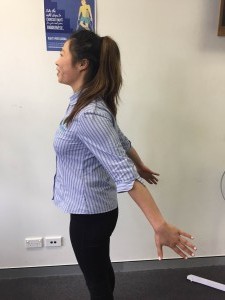Most people have little difficulty reaching in front of them, but very little attention is placed on how easily we can reach behind our bodies! Perhaps this is because reaching behind is not a common activity, or perhaps it is also because this movement isn’t as easy to perform as reaching in front or even overhead. Like all the joints in the body we need to be able to move in all available directions to ensure that they remain healthy and so that we don’t become biased to certain positions or postures.
The shoulder joint
The shoulder joints are similar to the hip joints in that they are essentially a ball and socket joint. The major difference between the hip and the shoulder lies in the depth of this ball and socket joint. Being more shallow than the hip, the shoulder joint is designed to enable great amounts of movement. This includes reaching forward and overhead, rotating, coming across the body and of course reaching behind.
Posture
Over time, poor posture can cause our shoulders and upper back to take on more of a rounded position that can cause the muscles at the front of the shoulder to become tighter. This not only changes the way that our shoulders move, but also makes it more difficult to reach behind as these tight muscles become resistant to stretching. The muscles at the back of the shoulder take on the opposite effect and become longer but also weaker at resisting the forward pull of these tight muscles at the front of the shoulder.
Test your shoulder
It is quite common to hear people injure their shoulders by reaching either behind or in front of them. So what is the solution? One potential solution is trying to increase the mobility of the shoulder – specifically into what is known as extension (or reaching behind the body). Test your own shoulder extension out by extending the arms behind your body. Keep the arms straight and raise them up as far as you can without bending forward at the waist. How far can you reach? You should be able to lift both arms to approximately the middle of your waist or higher.
If you found this test difficult or tight, you can work on your shoulder extension by using a simple exercise. Stand with your back to the wall and arms behind you touching the wall. Slowly walk one arm up at a time until you reach a good stretch and hold this position for around a minute. Remember there shouldn’t be any pain with this exercise, so if you do get pain do not continue with the exercise. You may need to talk to a health professional to discuss a more gentle option to get you started.

